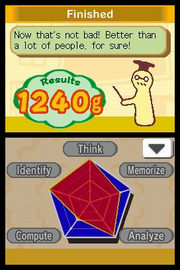No edit summary |
No edit summary |
||
| Line 21: | Line 21: | ||
The game contains fifteen different activities divided into five categories. They are as follows: |
The game contains fifteen different activities divided into five categories. They are as follows: |
||
*Think - Logic questions. Includes Heavyweight, Pathfinder, and Boneyard. |
*Think - Logic questions. Includes Heavyweight, Pathfinder, and Boneyard. |
||
| − | *Memorize - |
+ | *Memorize - Memory questions. Includes Sound Bites, Flash Memory, and Memo-random. |
*Analyze - Reason questions. Includes Missing Link, CubeGame, and Animal Lines. |
*Analyze - Reason questions. Includes Missing Link, CubeGame, and Animal Lines. |
||
*Compute - Math questions. Includes Coin-parison, Add Agency, and Written Math. |
*Compute - Math questions. Includes Coin-parison, Add Agency, and Written Math. |
||
Revision as of 16:16, 4 December 2010
Big Brain Academy (やわらかあたま塾, Yawaraka Atamajuku) is a Nintendo DS video game that was developed and published by Nintendo in mid 2006. It is a educational game, and is often compared with Brain Age: Train Your Brain in Minutes a Day!, another "brain game" which was released a few months earlier for the same system. It is part of the Touch Generations series.
Gameplay
Big Brain Academy differs a lot from Brain Age in terms of its approach to the brain training. Where Brain Age has scientific research behind the exercises and grading design, Big Brain uses a more user friendly approach, with vivid colors, peculiar images and a more puzzle-like activity design.
Activities
The game contains fifteen different activities divided into five categories. They are as follows:
- Think - Logic questions. Includes Heavyweight, Pathfinder, and Boneyard.
- Memorize - Memory questions. Includes Sound Bites, Flash Memory, and Memo-random.
- Analyze - Reason questions. Includes Missing Link, CubeGame, and Animal Lines.
- Compute - Math questions. Includes Coin-parison, Add Agency, and Written Math.
- Identify - Visual questions. Includes Shadow Shift, Get in Shape, and Matchmaker.
When playing one of the activities there is a time limit of 60 seconds, during which the player needs to complete as many questions as possible. Answering correctly also heightens the difficulty, and the amount of points received for a correct answer depends on the difficulty. Wrong answer lowers the difficulty though, in addition to losing valuable time and points. The score is calculated in grams, as in the brain mass.
Game modes

Dr. Lobe evaluating the player.
The main mode of play is the Test mode. The player is given to play one randomly chosen game from each of the five categories. When finished, Dr. Lobe will evaluate the player based on the performance. The weight of the brain is calculated basing on the results, and a graph will be shown where the player can see in which categories he needs to improve. Dr. Lobe will then give the player a grade, ranging from F- to A+, and a suitable profession to go with it.
In Practice mode the player can practice any of the exercises. Each activity has three difficulties to choose from, and depending on the score, a bronze, silver, gold or platinum medal might be given. The required scores differ slightly between games and difficulties.
2-8 players can also compete in the Versus mode. Activities are chosen randomly and the players compete to be the first one to answer the questions. Ten grams are added for answering correctly first, but wrong answers lead to points being subtracted. The one to reach a pre-determined target weight first wins.
Legacy
The game was successful enough to warrant a sequel, Big Brain Academy: Wii Degree as it is called, was released for the Wii in 2007. The game expands on the same kind of brain exercises, but has a lot of focus on multiplayer modes. The game also uses Miis heavily.
Big Brain Academy has also been referenced in other Nintendo games. In the Nintendo DS video game WarioWare D.I.Y., one of the microgames titled Shadow Shift has the players guessing which monster matches the silhouettes that roam about on the screen, just like the actual activity in the game. In Super Smash Bros. Brawl the game is referred in several ways. Dr. Lobe appears on two stickers, with artwork from both Big Brain games, and music from the game can be unlocked for use on the stage Distant Planet.
Reception
| Reception | |
|---|---|
| Aggregate scores | |
| Aggregator | Score |
| GameRankings | 75.73% (based on 48 reviews) |
| Review scores | |
| Publication | Score |
| 1UP | 9/10 |
| GameSpot | 7/10 |
| GameSpy | 3/5 |
| IGN | 8.1/10 |
Big Brain Academy was generally well received among the critics. It holds an accumulated score of 75.73% on Game Rankings, compared to Brain Age's 77.26%. Most reviewers praised the addictiveness of the game, and the fact that the exercises felt more like games than the ones in Brain Age. The multiplayer mode was also enjoyed by most critics. There was however disagreement regarding the game's variety. Many reviewers thought it bested its competitor, though others actually thought there was a lack of variety. The lack of progress tracking was otherwise one of the biggest complaints. Unlike Brain Age, only the best scores are saved, not a graph over results during a longer period.
The game was also a commercial success. While it didn't sell as well as Brain Age: Train Your Brain in Minutes a Day!, it managed to reach 5.02 million sold copies worldwide (as of March 2008), making it one of the bestselling games on the system.
Template:Touch Generations
